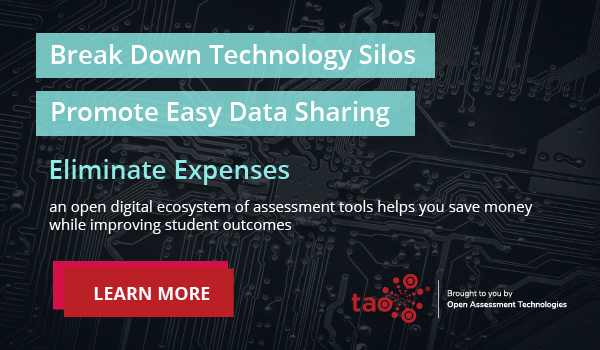Digital assessment can make it quicker and easier to design and implement tests at scale, increase accessibility, and simplify data collection and analysis. However many proprietary tools also tie you into expensive subscriptions and closed systems, leading to ballooning costs and difficulties customizing your platform.
We’re breaking down why schools, leaders, and governments are increasingly turning to open-source assessment software to harness the power of digital testing without the high costs and heavy restrictions of closed systems. Plus, we’ll explain how open-source assessment platforms are already making a difference.
Key Takeaways
- Open-source assessment software gives you free access to the program’s source code, which you can customize to suit your needs and integrate with other software in your ecosystem.
- The advantages of open-source assessment software include lower costs, greater flexibility, easy integrations with other programs, and smooth delivery at scale.
- For schools and governments, being able to introduce customizable software without breaking the budget can speed up digitization.
- Case studies from around the world show how governments and institutions have used open-source software to bring their testing online, build adjustable item banks, diversify their assessment types, and integrate testing platforms into existing ecosystems.
What Is Open-Source Assessment Software?
Assessment software gives you the power to build and deliver online, computer-based testing that students complete using an electronic device (for example, a computer, tablet, or even a cell phone).
It brings a number of key benefits, including easier personalization than paper-based testing, automated grading and instant feedback, more innovative question types, and faster analysis of results.
Some assessment software may be proprietary, i.e., copyrighted and purchased under license. You will not have access to the source code.
Open-source assessment software, on the other hand, has freely available source code. It can be used, modified, and redistributed without restrictions.
What Are the Advantages of Open-Source Assessment Software?
Introducing an open-source assessment platform brings several key advantages, including:
- Reduced costs: Open-source software is often freely available, cutting out the cost of an initial license fee and ongoing subscriptions.
- Increased flexibility: With access to the source code, you can customize the software to suit your institution. That could range from adding branding to using particular question types.
- Easy integrations: Open-source software isn’t limited to integrations with other programs from the same developer. Often, you can link the open-source platform to other software to increase its capabilities. For example, TAO plugs seamlessly into your EdTech ecosystem through the LTI open standard.
- More transparency: With open-source software, bugs and security problems are visible in the source code. Often, such platforms have developer and user communities that collaborate to solve issues and suggest fixes.
- Frequent updates: Open-source software may be regularly updated without the need to purchase an additional program. The update cycle can be faster than proprietary platforms, especially as users can more easily give feedback and develop their own improvements.
- Smooth delivery at scale: You can install an open-source platform across multiple institutions without incurring extra costs.
Why Are Governments And Institutions Turning to Open-Source Assessment Software?
Open-source software can transform assessment strategies at both an institutional and governmental level.
Compliance with Learning Standards
School districts or networks may need to meet both local and national standards. These may be related to digital privacy and security, accessibility for students with special educational needs and disabilities (SEND), or particular educational milestones.
With open-source software, you can customize the platform to meet your specific standards, which you can then roll out to all institutions if you’re part of a network. This makes it easier for individual schools to comply.
Agility and Flexibility
Introducing a digital approach can be tricky on a large scale, and there are likely to be speed bumps along the way. With open-source software, you can quickly adjust the platform on your own or with the support of the user/developer community.
That flexibility also extends to how your tools work together. Open-source systems are often designed with interoperability in mind, which means you can plug in other software to achieve your desired results faster and with less hassle, or transfer your material to or from another program.
For example, the QTI (Question & Test Interoperability) standard allows you to import and export questions that meet this standard across compatible platforms (like TAO), saving you the effort of creating a whole new question bank from scratch.
Cost Effectiveness
In an age of increasing costs, managing budgets is increasingly important at the institutional level and beyond. Because open-source software is free of ongoing license fees, you can focus your budget on making sure your IT infrastructure is solid, your staff are well-trained, and your students have the resources they need for success.
Case Studies
Looking at how governments, school districts, networks, and institutions worldwide have introduced open-source assessment software helps explain why this is an increasingly popular pathway. Here are some examples:
New York City Department of Education
The New York City Department of Education (NYCDE) wanted to make its world language testing more efficient at scale but faced challenges in delivering across all district schools and in multiple languages. Assessments also needed to be aligned with World Language proficiency standards, incorporating national and international frameworks for language teaching.
TAO’s open-source platform allowed NYCDE to conduct several pilot programs at low cost before upgrading to the subscription model. The district will now expand the testing model to serve over 60,000 students. They also plan to experiment with digital grading to reduce teacher workload.
Finnish Matriculation Board
The Finnish Matriculation Board wanted to build a bank of digital questions for online testing. They needed a platform that could serve as a repository and an item editor so educators could create, upload, and access resources to create online assessments. TAO’s QTI standards and open-source system meant it could be integrated with an existing content management system (CMS), cutting the time to implementation.
Swiss Conference of Cantonal Ministers of Education (EDK)
In Switzerland, the member states, or cantons, wanted to digitize nationwide testing but faced a complex system with multiple official languages and a decentralized model. TAO’s open-source platform reduced the cost by freeing them from using more expensive proprietary systems. It could also integrate with existing digital services across the varied cantons.
Tying Everything Together
Open-source assessment software can be cheaper, easier to customize, and more suitable for integrations with existing platforms and standards. As such, it can be an ideal way to explore the benefits of computer-based testing, both at an institutional and wider level. Case studies show that the flexibility of open-source platforms can help propel education systems into the digital age.
Open standards go hand-in-hand with open-source assessment software, and understanding how these could help transform your testing could be a great next step. Don’t forget that introducing any new software to your institution or network will require some careful planning to avoid pitfalls, including making sure staff are fully supported.
Find Out if Open-Source Assessment Software Is Right for You
It’s true that open-source assessment software comes with reduced costs and greater flexibility, among other advantages. But you might be wondering if it really would be suitable for your institution, and how best to introduce it. Scheduling a demo with the TAO team will help you understand if this could work for you.
FAQs
Is open-source assessment software free?
Many open-source assessment platforms will offer their source code for free. You may need to supply your own hosting framework and IT expertise, which will usually incur a cost. You may also choose to upgrade to a paid version of the software for more support and functionality.
What should schools and governments consider before introducing open-source assessment software?
Schools and governments should consider the ease of installing the software; the expertise they have in-house; how customizable the platform is; what support the platform provides; whether the software uses open standards; and security and privacy safeguards, among other things.

